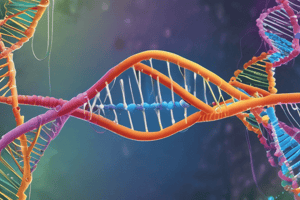Podcast
Questions and Answers
Flashcards
Transcription
Transcription
The process by which genetic information in DNA is copied into messenger RNA (mRNA) for protein synthesis.
Excision Repair
Excision Repair
A mechanism that removes and replaces damaged DNA, such as nucleotide excision repair, which corrects UV-induced damage.
Translation
Translation
The process by which ribosomes convert the genetic information in mRNA into a sequence of amino acids to build proteins.
Mismatch Repair
Mismatch Repair
Signup and view all the flashcards
Codon
Codon
Signup and view all the flashcards
PCR (Polymerase Chain Reaction)
PCR (Polymerase Chain Reaction)
Signup and view all the flashcards
Aminoacyl-tRNA Synthetase
Aminoacyl-tRNA Synthetase
Signup and view all the flashcards
Sanger Sequencing
Sanger Sequencing
Signup and view all the flashcards
Genetic Code
Genetic Code
Signup and view all the flashcards
DNA Polymerase
DNA Polymerase
Signup and view all the flashcards
Anticodon
Anticodon
Signup and view all the flashcards
Proofreading
Proofreading
Signup and view all the flashcards
Silent Mutation
Silent Mutation
Signup and view all the flashcards
Introns
Introns
Signup and view all the flashcards
tRNA (Transfer RNA)
tRNA (Transfer RNA)
Signup and view all the flashcards
Rosalind Franklin
Rosalind Franklin
Signup and view all the flashcards
Okazaki fragment
Okazaki fragment
Signup and view all the flashcards
Watson and Crick
Watson and Crick
Signup and view all the flashcards
ORI (Origin of Replication)
ORI (Origin of Replication)
Signup and view all the flashcards
Transformation
Transformation
Signup and view all the flashcards
Leading Strand
Leading Strand
Signup and view all the flashcards
Chargaff
Chargaff
Signup and view all the flashcards
Telomerase
Telomerase
Signup and view all the flashcards
Helicase
Helicase
Signup and view all the flashcards
Lagging Strand
Lagging Strand
Signup and view all the flashcards
Template
Template
Signup and view all the flashcards
Plasmid
Plasmid
Signup and view all the flashcards
Antiparallel
Antiparallel
Signup and view all the flashcards
Semi-conservative
Semi-conservative
Signup and view all the flashcards
Primer
Primer
Signup and view all the flashcards
Study Notes
DNA Replication and Repair
- Transcription: Copies genetic information from DNA into messenger RNA (mRNA) for protein production.
- Excision Repair: Removes and replaces damaged DNA, like UV-induced damage.
- Translation: Ribosomes convert mRNA into amino acid sequences forming proteins.
- Mismatch Repair: Fixes errors in DNA replication, like insertion, deletion, and mis-incorporation of bases.
- Codon: Three nucleotides in mRNA that code for an amino acid or stop signal.
- PCR (Polymerase Chain Reaction): Creates multiple copies of a DNA segment.
- Aminoacyl-tRNA Synthetase: Attaches the right amino acid to its tRNA.
- Sanger Sequencing: Method of DNA sequencing using chain-terminating dideoxynucleotides.
- Genetic Code: Rules for translating mRNA sequences into proteins.
- DNA Polymerase: Enzyme synthesizing DNA from deoxyribonucleotides (essential for replication).
- Anticodon: tRNA sequence complementary to a codon in mRNA.
- Proofreading: DNA polymerase's error-correction mechanism; removes incorrect nucleotides.
- Silent Mutation: Nucleotide change with no effect on the amino acid sequence.
- Introns: Non-coding DNA sequences removed from RNA during processing.
- tRNA (Transfer RNA): Carries amino acids to the ribosome during translation.
- Rosalind Franklin: Her X-ray diffraction images helped discover the double helix.
- Okazaki Fragment: Short DNA segments synthesized discontinuously on the lagging strand.
- Watson and Crick: Discovered the double helix structure of DNA, drawing on Rosalind Franklin's data.
- ORI (Origin of Replication): DNA sequence where replication starts.
- Transformation: Acquiring exogenous genetic material from surrounding environment.
- Leading Strand: DNA strand synthesized continuously during replication.
DNA Structure and Function
- Chargaff's Rules: DNA from any cell has a 1:1 ratio of A=T and C=G.
- Telomerase: Adds nucleotides to chromosome ends to prevent shortening.
- Helicase: Enzyme unwinding the DNA helix during replication.
- Lagging Strand: Synthesized discontinuously in short sections (Okazaki fragments).
- Template: DNA or RNA strand used as a guide for complementary strand synthesis.
- Plasmid: Small, circular, double-stranded DNA molecules.
- Antiparallel: Opposite 5' to 3' orientations of DNA strands in the double helix.
- Semi-conservative: In DNA replication, each new double helix contains one old and one new strand.
- Primer: Short nucleic acid sequence starting DNA synthesis.
Studying That Suits You
Use AI to generate personalized quizzes and flashcards to suit your learning preferences.




